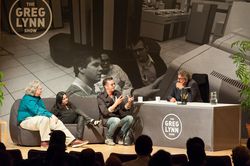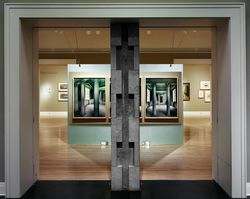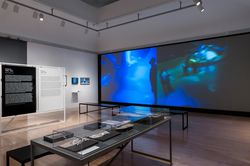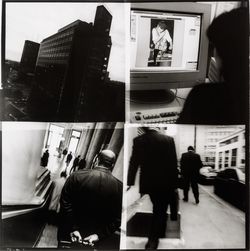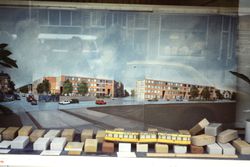En complément de l’exposition L’architecte, autrement, Todd Rouhe et Rachel Himmelfarb, de la firme common room, présentent leur processus de travail en collaboration : « Cette question – Quel est le problème? – anime la méthode de travail de common room. Elle définit le processus de recherche, d’expérience, d’interaction et de communication qui non seulement influence(...)
Théâtre Paul-Desmarais
19 novembre 2015
common room : Quel est le problème?
Actions:
Description:
En complément de l’exposition L’architecte, autrement, Todd Rouhe et Rachel Himmelfarb, de la firme common room, présentent leur processus de travail en collaboration : « Cette question – Quel est le problème? – anime la méthode de travail de common room. Elle définit le processus de recherche, d’expérience, d’interaction et de communication qui non seulement influence(...)
Théâtre Paul-Desmarais
The Greg Lynn Show
Greg Lynn sur scène, en conversation avec les architectes de projets inclus dans l’exposition __Archéologie du numérique : Complexité et convention_. Les conversations constituent un des aspects importants du programme Archéologie du numérique du CCA. Greg Lynn a ainsi discuté avec les architectes de projets produits de la fin des années 1980 jusqu’aux années 2000, afin(...)
11 mai 2016
The Greg Lynn Show
Actions:
Description:
Greg Lynn sur scène, en conversation avec les architectes de projets inclus dans l’exposition __Archéologie du numérique : Complexité et convention_. Les conversations constituent un des aspects importants du programme Archéologie du numérique du CCA. Greg Lynn a ainsi discuté avec les architectes de projets produits de la fin des années 1980 jusqu’aux années 2000, afin(...)
Tout comme la villa Rotonda d’Andrea Palladio a contribué à définir, pour les générations suivantes, l’architecture de la Renaissance en Italie, Chiswick est le locus classicus du renouveau palladien au XVIIIe siècle. L’exposition suit le déroulement de la pensée d’un grand architecte qui transforme successivement ses sources d’inspiration en projet architectural, puis(...)
Salles principales
19 juillet 1994 au 25 septembre 1994
Le renouveau palladien : la villa et les jardins de Lord Burlington à Chiswick
Actions:
Description:
Tout comme la villa Rotonda d’Andrea Palladio a contribué à définir, pour les générations suivantes, l’architecture de la Renaissance en Italie, Chiswick est le locus classicus du renouveau palladien au XVIIIe siècle. L’exposition suit le déroulement de la pensée d’un grand architecte qui transforme successivement ses sources d’inspiration en projet architectural, puis(...)
Salles principales
Environnements virtuels, objets interactifs marque la seconde étape du projet de recherche amorcé avec l’exposition Archéologie du numérique en 2013. Sous le commissariat de Greg Lynn, cette initiative explore les liens entre architecture et technologie numérique des années 1980 à la fin du XXe siècle. La première exposition s’intéressait aux pratiques émergentes(...)
Salles principales
21 mai 2014 au 5 octobre 2014
Archéologie du numérique : Environnements virtuels, objets interactifs
Actions:
Description:
Environnements virtuels, objets interactifs marque la seconde étape du projet de recherche amorcé avec l’exposition Archéologie du numérique en 2013. Sous le commissariat de Greg Lynn, cette initiative explore les liens entre architecture et technologie numérique des années 1980 à la fin du XXe siècle. La première exposition s’intéressait aux pratiques émergentes(...)
Salles principales
À la suite de la révolution du 25 avril 1974 au Portugal, larchitecte Alexandre Alves Costa est devenu membre du comité de coordination du SAAL pour le secteur nord, responsable de la planification et du soutien de projet. Avec José António Bandeirinha, architecte et professeur agrégé titulaire à lUniversité de Coimbra, il abordera lors de cette conférence le rôle nouveau(...)
Théâtre Paul-Desmarais
17 septembre 2015, 18h
SAAL 1974 : l'architecture portugaise s'ouvre au monde
Actions:
Description:
À la suite de la révolution du 25 avril 1974 au Portugal, larchitecte Alexandre Alves Costa est devenu membre du comité de coordination du SAAL pour le secteur nord, responsable de la planification et du soutien de projet. Avec José António Bandeirinha, architecte et professeur agrégé titulaire à lUniversité de Coimbra, il abordera lors de cette conférence le rôle nouveau(...)
Théâtre Paul-Desmarais
Projet
BMI/HQ
AP144.S2.D74
Description:
File documents the unexecuted design for the headquarters of the Birmingham and Midland Institute (BMI), in Birmingham, England. This project is related to the Shantasea Development (AP144.S2.D72) from which Cedric Price resigned as architect to take on the role of architect for BMI, one of the proposed tenants for the Shantasea project. Cedric Price proposed a municipal and regional "nerve centre" to house seminar and study rooms, workshops, galleries, film, television and music studios, a library, a planetarium, and a theatre. A flexible life-cycle plan (expansion, static, contraction) for the building and the activities would allow BMI to expand in the short and medium term, and to shrink in the long term, when it was assumed that many of its roles would be replaced by the UK's Open University plan (Works II, 42). Work on the project came to a stop in 1970 under a new city council (Architectural Design, June 1971, 368). Existing conditions material consists of maps and a survey of Birmingham. Conceptual sketches and drawings include: annotated diagrammatic plans and sections used to develop the building's massing and the horizontal/vertical relationships between functional areas; axonometric views showing the building's general form/functions; plans used for calculating square footage; diagrams showing visual and physical movement through the building; information and movement charts; and flow charts showing the building's organization. Design development drawings consist of graphs showing how functional areas might be used over time. Design development and working drawings include: diagrammatic plans and sections; exploded axonometric views of the functional relationships between areas; exterior axonometric views; sectional perspectives; space allocation plans; circulation drawings; diagrams showing activities throughout the day; furniture equipment schedules; theatre seating and stair studies; and elevations for exterior cladding. Charts show links between activities/actions; activity distribution; activity/capacity; progress of pre-contract work; and the telephone network. File also includes drawings by engineering consultants Felix Samuely and Partners and Zisman, Bowyer and Partners. Presentation material includes: newspaper clippings and text concerning the project; diagrammatic plans, sections, and charts; and a photo collage of the site; and a text by Cedric Price entitled "The Present Position". Some materials in this file were published in "Cedric Price Supplement No. 3", 'Architectural Design', vol. 41, (June 1971), 364-368, and 'Cedric Price-Works II' (London: Architectural Press, 1984), 36, 42. Material in this file was produced between 1967 and 1971. Zisman Bowyer and Partners appear as the mechanical and electrical consulting engineers; Silk and Frazier as the quantity surveyors; and Versa-Serve Ltd as the catering consultants on this project. File contains cartographic materials, conceptual drawings, design development drawings, panels, photographic materials, presentation drawings, presentation panels, publication drawings, technical drawings, and textual records.
1967-1971
BMI/HQ
Actions:
AP144.S2.D74
Description:
File documents the unexecuted design for the headquarters of the Birmingham and Midland Institute (BMI), in Birmingham, England. This project is related to the Shantasea Development (AP144.S2.D72) from which Cedric Price resigned as architect to take on the role of architect for BMI, one of the proposed tenants for the Shantasea project. Cedric Price proposed a municipal and regional "nerve centre" to house seminar and study rooms, workshops, galleries, film, television and music studios, a library, a planetarium, and a theatre. A flexible life-cycle plan (expansion, static, contraction) for the building and the activities would allow BMI to expand in the short and medium term, and to shrink in the long term, when it was assumed that many of its roles would be replaced by the UK's Open University plan (Works II, 42). Work on the project came to a stop in 1970 under a new city council (Architectural Design, June 1971, 368). Existing conditions material consists of maps and a survey of Birmingham. Conceptual sketches and drawings include: annotated diagrammatic plans and sections used to develop the building's massing and the horizontal/vertical relationships between functional areas; axonometric views showing the building's general form/functions; plans used for calculating square footage; diagrams showing visual and physical movement through the building; information and movement charts; and flow charts showing the building's organization. Design development drawings consist of graphs showing how functional areas might be used over time. Design development and working drawings include: diagrammatic plans and sections; exploded axonometric views of the functional relationships between areas; exterior axonometric views; sectional perspectives; space allocation plans; circulation drawings; diagrams showing activities throughout the day; furniture equipment schedules; theatre seating and stair studies; and elevations for exterior cladding. Charts show links between activities/actions; activity distribution; activity/capacity; progress of pre-contract work; and the telephone network. File also includes drawings by engineering consultants Felix Samuely and Partners and Zisman, Bowyer and Partners. Presentation material includes: newspaper clippings and text concerning the project; diagrammatic plans, sections, and charts; and a photo collage of the site; and a text by Cedric Price entitled "The Present Position". Some materials in this file were published in "Cedric Price Supplement No. 3", 'Architectural Design', vol. 41, (June 1971), 364-368, and 'Cedric Price-Works II' (London: Architectural Press, 1984), 36, 42. Material in this file was produced between 1967 and 1971. Zisman Bowyer and Partners appear as the mechanical and electrical consulting engineers; Silk and Frazier as the quantity surveyors; and Versa-Serve Ltd as the catering consultants on this project. File contains cartographic materials, conceptual drawings, design development drawings, panels, photographic materials, presentation drawings, presentation panels, publication drawings, technical drawings, and textual records.
File 74
1967-1971
Images parlantes
Sophie Dars et Carlo Menon, Stefano Graziani et Yasufumi Nakamori présentent des stratégies pour réinventer et employer des formats visuels tels le reportage photo, le roman photo et l’exposition de photos. L’événement s’inscrit dans le cadre d’un projet de recherche en cours au CCA portant sur la relation entre architecture et photographie, soutenu par la fondation(...)
13 octobre 2016, 18h
Images parlantes
Actions:
Description:
Sophie Dars et Carlo Menon, Stefano Graziani et Yasufumi Nakamori présentent des stratégies pour réinventer et employer des formats visuels tels le reportage photo, le roman photo et l’exposition de photos. L’événement s’inscrit dans le cadre d’un projet de recherche en cours au CCA portant sur la relation entre architecture et photographie, soutenu par la fondation(...)
L’enseignement de… Toronto
Ian Chodikoff, architecte, urbaniste et rédacteur en chef du magazine Canadian Architect, présente ses recherches sur la banlieue contemporaine, et sur les influences qu’exercent la diversité ethnique et le multiculturalisme sur l’architecture et l’esthétique urbaine dans les paysages suburbains de la région du Grand Toronto (RGT). Les banlieues d’aujourd’hui sont plus(...)
Théâtre Paul-Desmarais
4 mars 2010 , 19h
L’enseignement de… Toronto
Actions:
Description:
Ian Chodikoff, architecte, urbaniste et rédacteur en chef du magazine Canadian Architect, présente ses recherches sur la banlieue contemporaine, et sur les influences qu’exercent la diversité ethnique et le multiculturalisme sur l’architecture et l’esthétique urbaine dans les paysages suburbains de la région du Grand Toronto (RGT). Les banlieues d’aujourd’hui sont plus(...)
Théâtre Paul-Desmarais
archives
Niveau de description archivistique:
Fonds
AP176
Résumé:
Karl Chu X PHYLUM project records, 1998-2014 (predominant 1998-2002), documents the development and design process of Chu’s project X PHYLUM. The archive consists exclusively of original born-digital material.
1998-2014
Documents d’archives de Karl Chu pour le projet X Phylum
Actions:
AP176
Résumé:
Karl Chu X PHYLUM project records, 1998-2014 (predominant 1998-2002), documents the development and design process of Chu’s project X PHYLUM. The archive consists exclusively of original born-digital material.
archives
Niveau de description archivistique:
Fonds
1998-2014
Inter / Faces
Comment l’architecture répond-elle à un contexte urbain spécifique? Comment la diversité des typologies et les besoins culturels de ses habitants variés peuvent-ils influencer le design? Comment saisir l’essence d’une ville à travers ses bâtiments? Les projets de logement social « Bonjour Tristesse » et « Punt en Komma » de l’architecte portugais Álvaro Siza, conçus pour(...)
29 novembre 2015, 14h30 - 16h30
Inter / Faces
Actions:
Description:
Comment l’architecture répond-elle à un contexte urbain spécifique? Comment la diversité des typologies et les besoins culturels de ses habitants variés peuvent-ils influencer le design? Comment saisir l’essence d’une ville à travers ses bâtiments? Les projets de logement social « Bonjour Tristesse » et « Punt en Komma » de l’architecte portugais Álvaro Siza, conçus pour(...)

